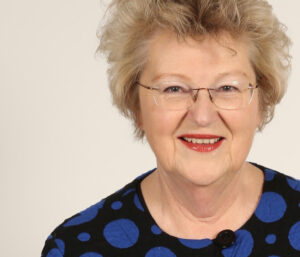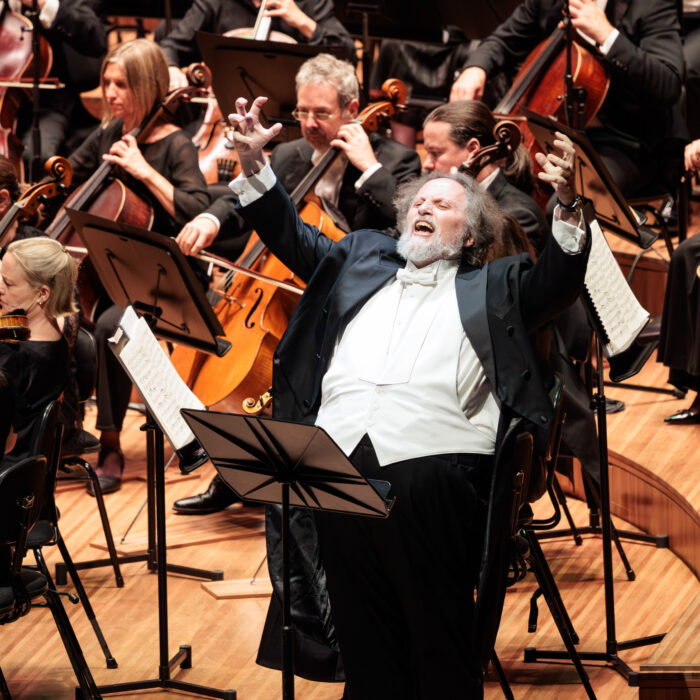
Komische Oper Berlin 2025 Review: Mahler’s ‘Symphony No. 8 in E-Flat Major’
The ‘Symphony of a Thousand’ Presented in Hangar 4 at the Former Tempelhof Airport
By Zenaida des Aubris(Photo: Jan Windszus Photography)
Gustav Mahler’s 8th Symphony in E-flat major, often dubbed the “Symphony of a Thousand” did its moniker justice this time: It was put on by the Komische Oper Berlin in the huge Hangar 4 at the former Tempelhof Airport and counted 1030 participants – taking up the entire center stage plus two grandstands for the choirs.
Gustav Mahler himself thought this was his masterpiece, with which he immediately thrilled almost everyone at its premiere in Munich on September 12, 1910. He worked on this piece with great zeal, and he was so convinced of his own creative genius, that he purportedly said “Imagine that the universe begins to sound and resonate this way.” To achieve this, however, Mahler needed a huge apparatus: at this particular performance there were the combined opera and chorus of the Komische Oper, plus the Deutsche Symphonie Orchestra, an organ, an extra wind section, four harps and the choir of the Rundfunkchor Berlin plus the Vocalconsort Berlin, plus a boys’ chorus plus eight soloists.

(Photo: Jan Windszus Photography)
Mahler’s Eighth Symphony is less a conventional symphony than a vast metaphysical fresco, a vision of creation and redemption painted in sound. A Catholic prayer book that Mahler came across is said to have provided inspiration for the first part, which, from the very first bars—when the choir begins with the fervent plea “Veni, Creator Spiritus”- come, creative spirit – transports one to a universe in which music and spirit are inextricably linked. This first part is not mere devotion: it is a hymn to life itself, to the wave of divine energy that breathes both inspiration and creative fire into humanity.
The second part transports us into Goethe’s “Faust,” not into the realm of drama, but into its final, transfigured moments, when Faust’s weary soul is lifted up to heaven. Here, the music casts off all earthly burdens: gentle choirs underlining the solo voices, which appear like guiding spirits, and nature itself seems to whisper salvation. The ascent becomes ever more radiant until the final Chorus mysticus – “Das Ewig-Weibliche zieht uns hinan” (The eternal feminine draws us upward) – crowns the work in a fireworks display of choral and orchestral splendor, with the eternal feminine drawing humanity upward to salvation. Mephisto is unable to plunge Faust into hell.
What Mahler achieves is a synthesis rare in Western music: the sacred and the secular, the medieval hymn and the modern poem, united in a colossal arc. The Eighth is about nothing less than the unifying power of love – creative, spiritual, eternal – such an overwhelming affirmation that when the final chords sound, one does not feel that a symphony has come to an end, but that the universe itself has revealed its harmony for a moment.

(Photo: Jan Windszus Photography)
Komische Oper’s general music director James Gaffigan gave clear and lively indications for all to follow. Of course, the sound was amplified and this proved to be a detriment in the first half, which has dense orchestration, creating a carpet of sound. Mahler’s unmistakable harmonies, his mystical choirs float above shifting orchestral colors, with the solo voices of Soprano I (Magna peccatrix), Christina Nilsson, Soprano II (Una poenitentium) Penny Sofroniadou, Soprano III (Mater gloriosa) Elisa Maayeshi, Alto I (Mulier samaritana) Karolina Gumos, alto II (Maria aegyptiaca) Rachael Wilson, and the men including tenor Andrew Staples (Doctor marianus), baritone (Pater ecstaticus) Hubert Zapiór, and bass (Pater profundus) Andreas Bauer Kanabas. David Cavelius was in charge of the choirs, and Dagmar Barbara Fiebach was in charge of the children’s choir.
However, in such a huge hall, not everyone can expect absolute acoustic perfection. There were good seats and there were not so good seats. Granted, due to the amplification and the distance, it was difficult to keep the soloists apart. In fact, the sound engineers need to be commended since the physics of sound, the sheer distances sound waves need to travel, all stay in sync, must be a science upon itself, especially in a space that used to house aircraft.
This event had been planned way before the current austerity cuts affected the Komische Oper’s budget and there had been discussions about whether to even mount such a mega event or not. Thankfully, the two planned – and sold-out – performances took place, for the enrichment of Berlin’s music lovers.



